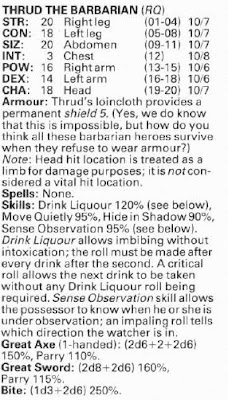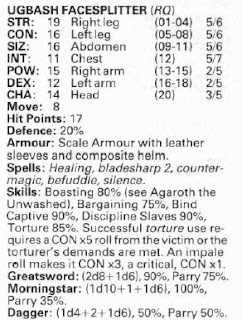For
the 50th Issue, our old reliable chum Phil Masters is in charge of a “special edition” Fiend Factory that
provides stats for the various characters that have come to grace the pages of
White Dwarf. These are semi-serious at best, with dual stats for Dungeons and
Dragons and RuneQuest.
Could
you use these in a game? In theory, yes. A few of them –Griselda and Wolfhead,
Ugbash and Agaroth – would easily make for regular NPCs with no gimmick
attached.
There was also a boxed set of minis that came was produced to go with this, which I owned but sold many, many, years ago.
First
up is the magazine’s mascot, The White
Dwarf himself.
Kind
of a tricky individual to produce stats for, since the White Dwarf is only ever
a little icon, and has never, in 50 issues of the magazine, expressed any
personality (unlike, say, The Mighty Tharg of 2000AD). And so Phil attempts to
encapsulate both a typical dwarf, plus the ethos of the magazine generally.
Gobbledigook is a goblin
character that features in the eponyomous strip by the artist Bil. So far in
its run at this point in the magazine, the Gobbledigook strip has been a 3-4
panel affair, mostly simple jokes about Gook’s mindless violence and foolish
curiosity. Gook occasionally works for the evil wizard Wizilevard, beats up the
wise sage Gaxygygar and is followed around a small furry thing (which we later
learn is called Niibl).
Thrud The
Barbarian
is another cartoon strip character, this time by Carl Critchlow, a parody of
characters such as Conan, Kyrik, Kull and other “mighty men of renown” from
classic sword and sorcery stories. He’s big and tough, but incredibly stupid,
with a tiny head on top of his muscle-bound body. Thrud’s occasional wizardly
mentor, the necromancer To-Me-Ku-Pa, bears an uncanny resemblance to
Wizilevard.
Griselda and Wolfhead are two RuneQuest figures from
Oliver Dickinson’s stories set in the Gloranthan city of Pavis; they managed to
find their way into official RuneQuest material and so here we only get their
D&D stats. Dickinson’s stories, told in the style of Damon Runyan’s Guys
and Dolls, are great fun and colourful. Griselda is a spunky redhead
adventuress living by her wits and sword in a dangerous city. Wolfhead, a
silent protector figure, doesn’t feature as much; they’re not really a double
act as such. But eminently usable.
The
next two characters began life in an increasingly elaborate series of full-page
adverts for the Games Workshop Mail Order service. Initially they were just
colour notes, with Agaroth the Unwashed
declaring words to the effect of “Listen, Man Things, Use Games Workshop Mail
Order, or else”.
As
time went on, the pantheon of characters grew, and a background grew with them.
Later additions to the pantheon were Gunatha, a zombie with a teddy bear (who
also became a character in his own right) and a deranged grandmother figure.
These characters were also expanded in a small “official fanzine” that was sent
out bi-annually to subscribers, called “Black Sun”. Hence, Ugbash Skullsplitter’s allegiance to the Slavers of the Black Sun.
Again,
joke characters, but eminently usable as viable villains.
In
the end, I chose Livingstone The Editor.
Although Griselda, Wolfhead, Agaroth and Ugbash would make decent sensible
statistic blocks, I wanted to convey some of the sense of fun from this
article. And also, having started this whole series off with a monster created
by Ian Livingstone, it seemed good to come full circle and create Ian
Livingstone as a monster.
Phil
was a little harsh on the poor man with his terrible statistics, so I’ve toned
those back, but tried to keep the general sense of portraying a man who loves
pubs, money and gaming, and who is a kind of beloved tyrant to his underlings.
And also, all of the elements work as viable 5th Edition options for
adding flavour to a character, in keeping with the sense of the original
article. You could even, for example, interpret the Damage Immunity to
Criticism to mean that, say, vicious
mockery would not work on Livingstone. The poison pen did acid damage under
the RuneQuest rules, but I changed it to poison, because it just didn’t sound
right otherwise.
|
Livingstone the Editor |
||||||||||||
|
Medium humanoid (human?), chaotic barwards |
||||||||||||
|
Armour Class 12 (
thick skin, hard head) Hit Points 11
(2d8 + 2) Speed 30 ft., 50 ft towards lucrative book and
computer game contracts |
||||||||||||
|
||||||||||||
|
Proficiency Bonus +2 Skills Intimidation +4, Perception +3,
Persuasion +4 Tool Proficiences brewer’s kit, gaming set (RPGs), writers tools Damage Immunities criticism Condition Immunities inebriation Senses passive Perception 11 |
||||||||||||
|
Languages
Common, Gaming-Speak |
||||||||||||
|
Challenge 1/8
(25 XP) |
||||||||||||
|
Editor’s Eye.
Livingstone has advantage on Wisdom (Perception) checks to spot spelling
mistakes and grammatical errors. Gamer’s Luck (3/Day). Livingstone
can reroll any dice roll, choosing the best result. Influence.
Livingstone uses double his Proficiency bonus on Intimidation and Persuasion
checks against gamers (already included in statistics). Writer’s Flourish.
Livingstone has a +2 bonus to any checks when using writing implement,
including attacks with his poison pen (already included in statistics). ACTIONS |
||||||||||||
|
Baseball Bat. Melee
Weapon Attack: +1 to hit, reach 5 ft., one creature. Hit: 3 (1d8-1) bludgeoning damage. Poison Pen. Melee
Weapon Attack: +4 to hit, reach 5 ft., one creature. Hit: 5 (2d4) poison damage. |


















Comments
Post a Comment